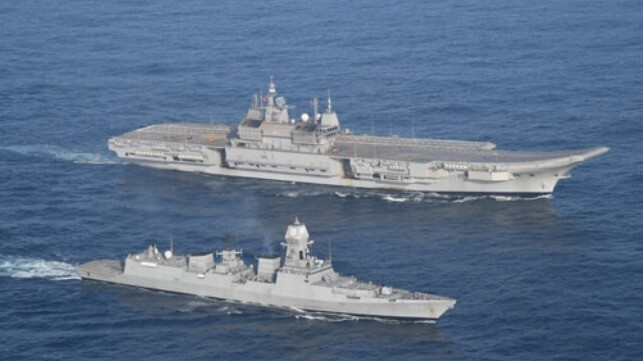The Indian Navy's Aircraft Carrier Dilemma

The late General Bipin Rawat, India’s first Chief of Defence Staff, took a dim view of aircraft carriers. He considered them expensive and unnecessary. In his telling, including with pointed remarks in June 2020, the Indian military was “not an expeditionary force” and had no need to deploy aircraft carriers in faraway places. Moreover, he felt such ships were vulnerable to sea-launched and shore-based missiles. The general rather seemed to favour submarines, which he noted were important for defence, and did not, unlike aircraft carriers, require a screen of battleships for protection.
The Indian Navy has traditionally been wary of such reasoning, seeing the aircraft carrier as a vital asset at the heart of maritime strategy. The flattop, Indian experts say, has the decisive ability to tilt the psychological balance in the littorals by ensuring a continuous and visible presence that complicates the cost-benefit calculus of the adversary. The large deck carrier, or supercarrier, with a catapult launch system is especially favoured for its ability to operate heavy, long-range multi-function aircraft.
But the navy last year unexpectedly dropped its demand for a large carrier. Admiral R. Hari Kumar, the current naval chief, announced at the Navy Day press conference in December 2022 that the next flattop would be a small one. He confirmed the decision last month, disclosing that the navy was planning a repeat order for the 45,000-tonne Vikrant, India’s first indigenous aircraft carrier, while still looking for a larger aircraft carrier design in future.
There are two ways to interpret this reversal. The first is that the navy is in a fiscal situation in which building a large aircraft carrier is no longer feasible. The Modi government’s guiding mantra today is Atmanirbhar Bharat (self-reliant India) and naval planners are under growing pressure to indigenise by 2047. Capital allocations are also down (in relative terms) as a result of the pandemic and the war in Ukraine, while the government has made a severe cut in the procurement of foreign systems. So aside from the time and resources required to develop a design for a large aircraft carrier, India’s naval planners are unsure whether the imports required to construct a large aircraft carrier will materialise. The option of a smaller carrier would also ensure that Cochin Shipyard’s experience in building the Vikrant will not be wasted.
The navy could begin inducting indigenous twin-engine deck-based fighters by the end of this decade. To operate these aircraft, which are intended to replace the MiG-29Ks, the navy will require at least two operational aircraft carriers. A large deck carrier is not in the navy’s plans because entering service would take over two decades.
Nonetheless, switching from a supercarrier to a small flattop creates a dilemma for the navy. The problem with a light carrier is that it isn’t fit for purpose in today’s complex and contested maritime environment. In wartime conditions, a small carrier is constrained in its operations, particularly when faced with the adversary’s anti-access, anti-denial systems. Since a small flattop does not operate heavy planes that require a catapult system for take-off but also typically have longer ranges, the ship has little option but to operate within the engagement envelope of the adversary’s shore-based missiles and air defence systems.
But small carriers are also less capable than large deck carriers in other critical respects. Unlike big carriers that are mostly nuclear-propelled and with sufficient power to manoeuvre continuously in the sensitive littorals, small flattops have conventional propulsion (gas-turbine or diesel), which offers less power. That translates into lower flexibility and less agile operations. While large aircraft carriers can serve as a floating base and deploy for extended periods of time, a small flattop has a shorter operational range, a lower sortie generation rate, and less endurance. Compared to a big carrier, small flattops also have less potent onboard defence systems and are particularly vulnerable to drone swarm attacks.
While small deck carriers are certainly useful in peacetime presence operations, their combat role is limited, unless their air wing comprises a powerful aircraft, such as the F-35B, with increased range, lethality and survivability. Notably, the fifth-generation carrier-based fighter is capable of deploying precision munitions at long ranges without risking the loss of aircraft or aircrews. The Indian Navy, which is likely to fly MiG-29Ks and Rafale Marines (or F/A-18 Super Hornets) from its small aircraft carriers over the next decade, may well succeed in deterring adversaries during a conflict. But it is hard to predict how Indian carriers with unproven aircraft will perform in a hostile environment.
The navy’s decision to replace the demand for a large deck flattop with a small aircraft carrier may appear driven by expediency, but it is really the result of dwindling options. Although no substitute for a large carrier, a small flattop is the Indian Navy’s only feasible choice. Notwithstanding the ship’s limitations, particularly its limited warfighting ability, a second Vikrant is all that the navy can hope to get in the current circumstances.
A former naval officer, Abhijit Singh, is a Senior Fellow at New Delhi-based Observer Research Foundation and head of the Maritime Policy Initiative. A maritime professional with specialist and command experience in front-line Indian naval ships, he is a keen commentator on maritime matters and writes regularly on security and governance issues in the Indo Pacific region.
This article appears courtesy of The Lowy Interpreter and may be found in its original form here.
The opinions expressed herein are the author's and not necessarily those of The Maritime Executive.
